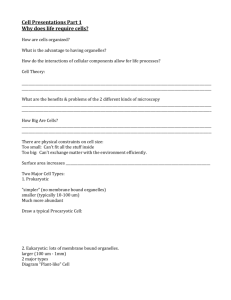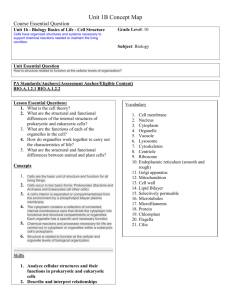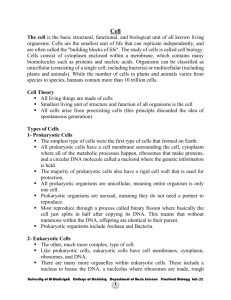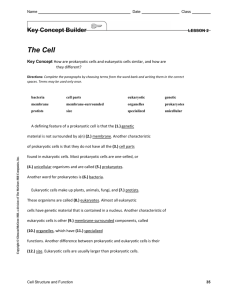Eukaryotic Cells - Academy of Our Lady
advertisement
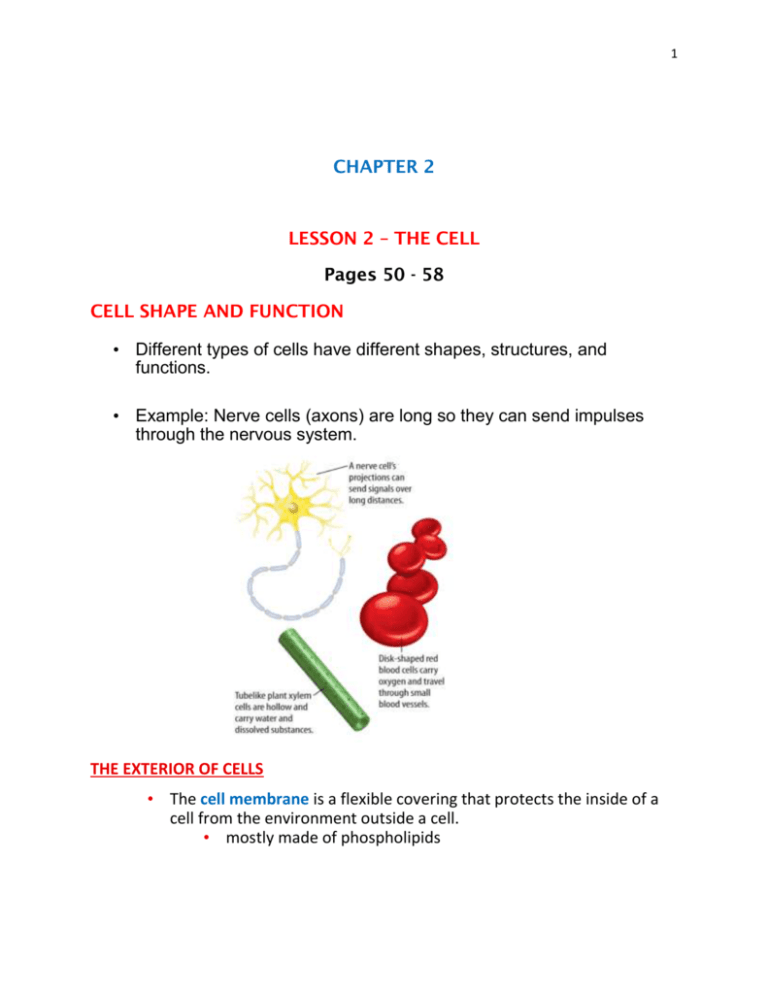
1 CHAPTER 2 LESSON 2 – THE CELL Pages 50 - 58 CELL SHAPE AND FUNCTION • Different types of cells have different shapes, structures, and functions. • Example: Nerve cells (axons) are long so they can send impulses through the nervous system. THE EXTERIOR OF CELLS • The cell membrane is a flexible covering that protects the inside of a cell from the environment outside a cell. • mostly made of phospholipids 2 • A cell wall is a stiff covering of cellulose outside the cell membrane. It provides protection. • Plant cells, fungal cells, and some protists have cell walls. • Animal cells do not have a cell wall. • Cell Appendages • They are found on the exterior. • Some kinds of cells have them. • The flagellum is a tail-like structure. o The single-cell euglena, a protest, uses this for moving in water. • Cilia are fibers on the outside. o The single-celled paramecium uses them for moving. o Lung cells use them for moving fluids and particles. THE INTERIOR OF CELLS Cytoplasm • This is the fluid inside cells. • It is mostly water. • It contains ions (salts), other molecules, & the cytoskeleton. Cytoskeleton • This is a network of threadlike proteins joined together. • It gives a cell its shape. 3 Cell Types • With more advanced microscopes, scientists discovered that all cells can be grouped into two types: o prokaryotic cells o eukaryotic cells Prokaryotic Cells • • • • Most prokaryotic cells are unicellular organisms called prokaryotes. They have no nucleus. They have fewer cell parts (organelles) than eukaryotes. Organisms in the domains bacteria and archaea are prokaryotes. a prokaryote Eukaryotic Cells • Plants, animals, fungi, and protists are all made of eukaryotic cells and are called eukaryotes. Eukaryotic cells are larger and more complex than prokaryotic cells. • Eukaryotes have membrane-surrounded organelles. • The genetic material in eukaryotic cells is surrounded by a membrane to form a nucleus. 4 plant cell animal cell Organelles in Eukaryotic Cells • Each type of organelle has a specialized function. • They enable the cell to carry our different functions at the same time. The Nucleus • • • • It may be the largest organelle in the cell. It directs cell activities. It contains DNA, proteins, and a nucleolus, seen as a dark spot. DNA stores genetic information. o It is organized in structure called chromosomes. o Different species have a different number of chromosomes. • The nucleolus makes organelles called ribosomes. o They are involved in the production of proteins. • The nucleus is surrounded by 2 membranes called the nuclear envelope. o Pores in this let some molecules move through. Ribosomes • They are organelles without a surrounding membrane. • Proteins are made on them. • Ribosomes are located in the cytoplasm. • They may be attached to another organelle, the rough endoplasmic reticulum. 5 Endoplasmic Reticulum (ER) • It is spread though most of the cytoplasm. • Two kinds: Rough and smooth • Rough ER has ribosomes on the surface. o Proteins are made on rough ER. • Smooth ER lacks ribosomes. o It makes cholesterol and other lipids. o It can help remove harmful substances from the cell. Mitochondria (see p. 59) • These organelles process energy. • Most eukaryotic cells may contain hundreds. • A mitochondrion is surrounded by 2 membranes. • Chemical reactions in mitochondria release energy that gets stored in high energy molecules called ATP. o ATP stands for adenosine triphosphate. o It provides energy for growth, cell division, and transport of materials. Chloroplasts • These organelles are found in plant cells and some protists such as algae. o Not present in animal cells • Chloroplasts are surrounded by a membrane. • They contain chlorophyll. • Chlorophyll is a complex molecule involved in photosynthesis. • With photosynthesis, water and carbon dioxide are used to make glucose (a sugar) and oxygen. o Sugar stores chemical energy. Processing, Storing, and Transporting Molecules • The Golgi apparatus prepares proteins for their specific functions and packages the proteins into vesicles. • Vesicles are tiny organelles that transport substances from one area of a cell to another area of a cell. Each vesicle has a membrane. 6 • Vacuoles—organelles found in some cells—store food, water, and waste material. o Some animal cells may have many small vacuoles. o A plant cell may have one large vacuole. See pages 52 & 53 for plant and animal cells. Animal Cell:


